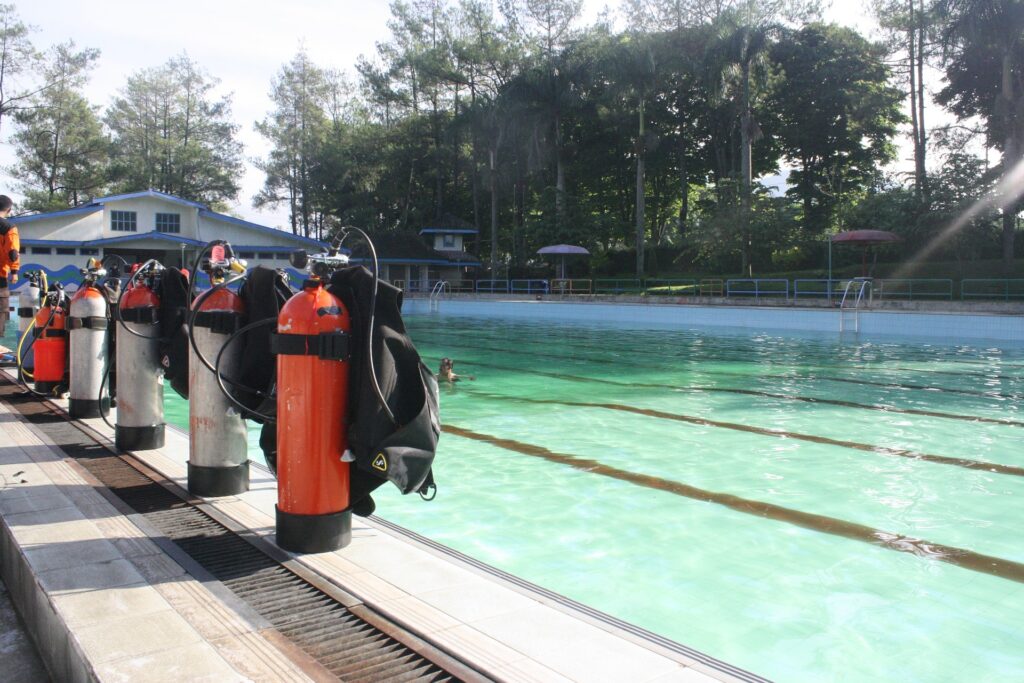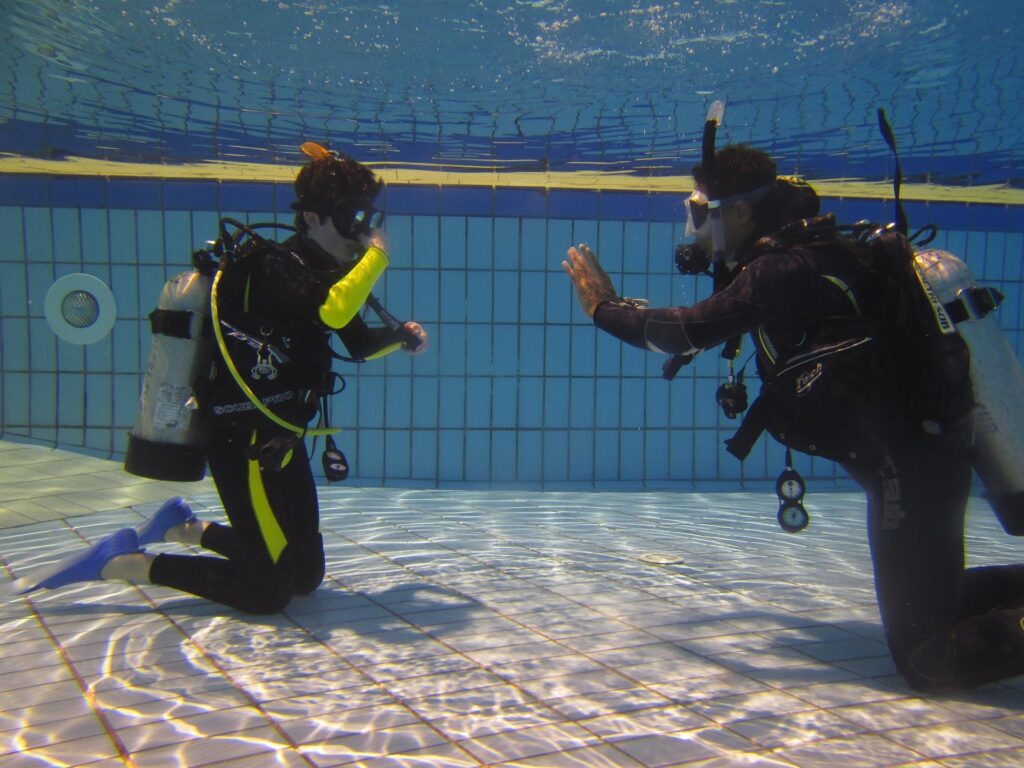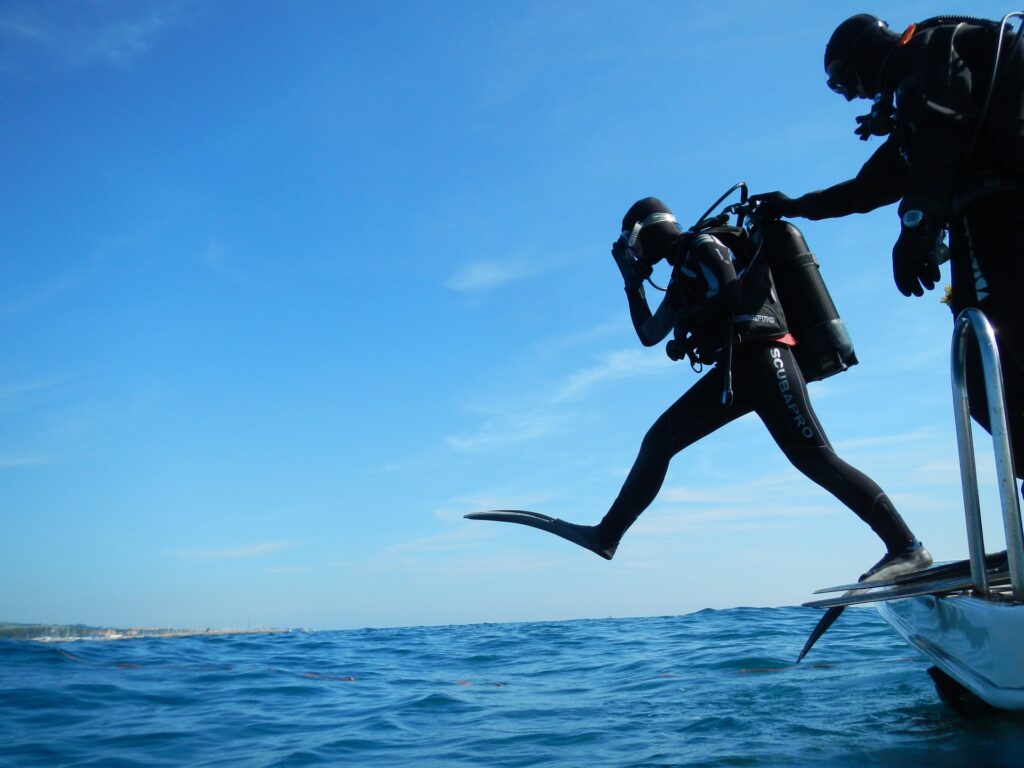At nearly 47 years old, I was asked if I would like to get scuba diving certified. This had not been anything I wanted to do, really. In the past I had thought about it, and the idea of being underwater, breathing through this “thing”, ensconced in all this gear with all that VASTNESS around me gave me horrible feelings of claustrophobia. I AM claustrophobic and had read some folks have this problem with scuba. So, I always figured this was a “no” for me.
But…this time I said sure, why not? My partner has tons of diving experience but had never been certified. So, we ventured into our Open Water Certification together.
Online Learning
First was the book-learning part – nowadays all online, but a person can do this at a dive shop as well. As we only had about a month to get this portion done, it was easiest for us to do it online. There were five sections with tests all the way, and then a “final exam”. In general, I didn’t find this too challenging, and it was fun to learn new things. I did get hung up on some of the math involved, and tended to get some things backwards, but after enough testing and review, I did pass my exam easily. What did I learn in this part?
- DON’T EVER STOP BREATHING OMG YOU WILL DIE
- Don’t ascend too fast or OMG YOU WILL DIE
- Take your time descending to make sure you equalize your ears properly or OMG YOU WILL DIE
- There is MATH involved. But computers and apps are available, so I don’t have to worry about this. Math is my arch nemesis. Won’t die.
- There is a lot to remember. Won’t die.
- Don’t panic. And I am NOT a person who panics, so I’m good. Well, not so far…
At this point, I asked my social media friends for any advice, as I know a good deal of people who scuba. I got lots of wonderful support, was advised it was great to be part of the “mermaid world”, it is amazing, you will love it, good for you…. I felt great! Everybody says it is so amazing! I have this. (Don’t panic, won’t die)

Getting in the Water in the Pool
Next step was to travel to Islamorada, FL to do our water portions of getting certified. A person is required to do two pool or enclosed dives, and then four open water dives. During all of this you have to learn and be tested on a number of skills. Somehow I didn’t quite grasp this fact to begin with. This testing. Or, more clearly, this stressful part. (Don’t panic, won’t die)
Upon meeting our instructor, who we liked very much immediately, we proceeded to the pool. It was gray and dreary this day, very unusual for Islamorada. But warm, so no problems there, it was just gloomy. I was silently starting to feel panic rise in me. But, I am not a person who panics, outwardly anyway. So, I kept going. I mean, what would happen? We are in a POOL for crying-out-loud. And my buddy is highly experienced, and it was just the two of us with our instructor. So I was in GREAT hands. (And I was). (Don’t panic, won’t die)
First, we had to complete a couple of tests to ensure we were physically fit to do scuba. This was an amount of swimming and treading water. Both of which were really no problem, and it was nice to know this part was required, to further along the fact that getting certified is Serious Business!
Next, I was presented with my scuba gear: BCD (Buoyancy Control Device, learn it, say it), tank, regulator, fins, snorkel, mask. We were taught how to assemble our gear – the first thing to freak me out. What if I assembled it all wrong and DIED?! But, I got to do it 4-5 more times altogether, and in the end I realized I was also able to watch others and even better, my buddy had done it before. And then there is this thing called Buddy Check, where you check with your buddy that you both did everything properly. Serious Business! (Don’t panic, won’t die)
I already have forgotten how to do this, so here is a great article instead to go read:
How to assemble your scuba gear
Now it was time to actually get in the pool with all our gear, and start learning VITAL SKILLS which we had to master before getting certified…
Mask Skills
It NEVER occurred to me that something that sounds so simple would freak me out. But it did! The moment I was told I was going to have to willingly put water in my mask and clear it out underwater I started to panic. This was so crazy to me. There were so many things I was afraid of: dying, claustrophobia, sea monsters, freak deaths, stopping breathing, getting stuck or lost, etc. But this was never a concern! And yet, here I was. PANIC.
But guess what? I did it. And it WORKED. This still shocks me every time I do it. It doesn’t make sense. But it works! You just push or tilt a little and BLOW with nose and ta-da! All clear. Nobody dies. I did do it a number of more times, which I was glad of because when we were doing the open water dive parts, the first dive my mask kept leaking! But I was easily able to clear it out no trouble. RELIEF.
Then there were more skills like just swimming with this weird BCD and tank and learning to breath with a regulator. I was very surprised that using the regulator and breathing underwater didn’t bother me at all. It just seemed normal. This was one of the things I was most afraid of, and here it was just <nothing>! But not to worry, I realized I had a new thing to worry about: Buoyancy.

Buoyancy
Buoyancy is another thing I never considered as a concern with learning scuba. I never even gave it a thought. The goal of buoyancy is that you want what is called “neutral buoyancy” where you just “hover” easily under the water. You don’t want to touch the ground, because who knows what is there and also you don’t want to harm any coral or fish, etc. So you want to be just perfectly neutral. This was so challenging for me and plagued me the entire time. In the pool I just had a horrible time trying to sort this out. Eventually I must have done it well-enough that my instructor decided I would be OK in the open water and be able to practice more with the less-confined space.
We had a light lunch, and then headed to our boat! Thankfully, the place we dived with was not huge, and there were maybe eight other people on to go diving. Only one other person was with our instructor, and he was doing part of his Advanced certification (well, he was hoping to, that is… until I got there…)
Open Water Dives
Let me preface all this with the fact that I am known to get motion sick. I take non-drowsy Dramamine (or whatever generic), and sometimes also use some wrist bands and this usually does the trick. I am aware I need to have food in my stomach also. I realize that doesn’t make a lot of sense, but if I don’t have food in my stomach and take a Dramamine, it won’t work. I was well-prepared with wrist bands, double Dramamine, and also some ginger supplements, food, and water on board with me.
Being on the boat was a little freaky for me. I had been out on a boat in the ocean a number of times to go snorkeling, but this was all unknown to me, and felt chaotic. I did my best to remain calm, but the panic seemed to be rising thinking of what was expected of me next. Plus, the weather… The weather continued to be total shit. Gray, gloomy, WINDY. I expected beautiful blue water with sunshine and zero waves. I did not get this. In fact, looking back, it turns out I was doing my first dives ever in what many experienced divers wouldn’t do! But I did not know this at the time and figured that well… The dive center knows what they are doing and I trust them and my instructor.
I will add – that in the end, although it was not ideal weather, it did give me an attitude that if I could dive in THAT, pretty much everything else will be no problem. I learned in the WORST, so, can only go up from there! (Kinda like learning to drive on ice & snow coated roads of the Upper Peninsula of Michigan, which is exactly what I did when I was 16)
Going in the Water
We were soon told we would be at our dive location soon, and to get ready. Now here I am a lot spooked because of course now I have forgotten how to get my tank and gear ready! But no worries! My buddy is there to help me and it started coming back to me, mostly. I was just really thankful to have somebody with me who knew what they were doing. It felt a LOT chaotic to me but I continued to persevere. I had gotten this far, dammit.
Time to get in the water!
To get in the water, you have all your gear on, hold onto your mask on the back (this keeps it on just in case the force of jumping in makes it slide off), and hold onto your regulator in your mouth and do a big stride jump off the back of the boat. I took a great big breath and went for it.
I had done some snorkeling in the ocean in the past, so I was familiar with it, but having all this gear on was a whole other matter. The next step is to go under the water, and start sinking down. My gosh I was freaked to do this. But I did it. And actually, it was so much calmer under the water than it was above with all the waves and wretched weather, it was a relief.

Descending the First Time
Under the water, my instructor was right there, signaling me to start going down the line (a rope in the water attached to the boat). My buddy was also there, but below as he had more experience descending. This was a real challenge for me. I could only go down so far before the pressure started to bother my ears and I would have to stop. I tried and tried and tried to get my ears to equalize but it was very difficult. I would go a little and the pain would start and I’d signal I had to stop, or go back up a little. So, so, so, so hard to do. FINALLY though, I was able to get down far enough and equalize my ears properly.
Under the Water the First Time
Once fully descended to nearer the bottom, I then needed to start to figure out how to be neutrally buoyant, breath properly and try to relax. I was really so surprised that being in the ocean like this and breathing through this device seemed totally natural, and I had zero claustrophobia. That was all perfectly fine. What I had the worst time with was staying neutrally buoyant. I was constantly floating UP UP UP, or then being worried I would sink sink sink and touch something I wasn’t supposed to! Occasionally things were fine, and I tried to enjoy things and relax but I really didn’t enjoy this first dive.
…or the second dive. 😊
Ascending the First Time
When our time below was finished, it was time to ascend. We were not very deep, this being our first open water dive, and so we didn’t have to do a decompression stop. This is done usually so that your body can decompress properly from the nitrogen your blood accumulates while you are underwater. It’s kinda freaky really, that you could ascend to quickly and then die later. So I took this all very seriously. But of course everybody does so I wasn’t really that worried about this in particular.
We followed the line back up to the surface. The wavy, windy gray surface. Getting your fins off in the water was impossible, but I somehow did it. Then I somehow also managed to climb up the ladder to get on the boat, hobble my way to a seat and unload all my gear. Did not die! Oh but now I started to feel some motion-sickness starting up. I could feel myself turning green. I found my stuff and gobbled down a granola bar, water and another Dramamine. Then I sat, thinking about things and try to put a smile on my face. Everybody else on the boat was so excited and happy! But here I was sick, deaf because my ears were plugged, miserable, exhausted and freaking out more than ever.
The weather did not get better, as much as I hoped we would be done for the day. As we neared our second dive site, I got more and more panicked and nervous and still felt sick. I was on the verge of tears and incredibly stressed out. But I did keep trying my best to smile at people as I didn’t want to bring anybody down. We went through the whole “Get your gear ready and gear up NOW!” process (ugh), and waited for the next stop. The entire time I was seconds away from saying no, I wasn’t going to go. I wanted to say no so badly. I did NOT want to go back down there. No way. But I took a big deep breath and did it.
The Second Dive
My biggest fear was really the pain in my ears going down. I had talked to my instructor about this on the boat in between dives so we were prepared and had more solutions in mind. Also the other person with us doing his Advanced Open Water certification had a tip for me that was super helpful. The part where they say to plug your nose and blow out your ears works for some folks, but it didn’t work for me. His suggestion was to do this thing with jutting my lower jaw out instead, and that actually worked much, much better. It definitely went a lot better the second time, thankfully. There was still some, but not nearly as much.
I mostly again tried in vain to stay neutrally buoyant, not float up up and away, not lose the group (this would never have happened but I worried about it anyway), and just stay calm.
Eventually it started getting better… stay tuned.
